Imdanny
Ideal_Rock
- Joined
- Jan 21, 2008
- Messages
- 6,186
Rockdiamond said:The surprise- and might be a mistake - is cushion, at 1746, number two on this particular list.

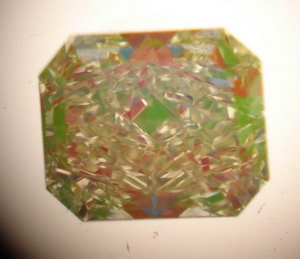
Rockdiamond said:Here is an example of a well cut crushed ice stone that is slightly lesser in cut.
There's a larger refelction in the table that you want if you're looking for consistent crushed ice.
In this case, we can see a clear correlation with the aset
Still- the area in the center does not allow you to see through the diamond- you won't see skin through it.
AS the stone moves that area is not very obvious.
Not the very best in crushed ice, but still quite nice to my eye in person.
AGBF said:Hi Garry, Karl, and other diamond tradespeople and engineer types-
I wish I could say that I come in peace, but I'm really a little annoyed. I started a thread about using cushion cut stones for earrings here:
rockytalky/are-cushion-cut-diamonds-used-as-stud-earrings-t149158.html
and if I do buy the stones I will be an actual diamond consumer, the type Pricescope is supposed to help, but I find you guys in a huddle talking to each other for 18 pages because that's more interesting.
Look...I know it's more interesting to talk to your peers, but I need some information here. I actually read some of this thread in desperation and it scared me even more. I wanted (past tense) to buy cushion cut stones to use in earrings because I wanted square stones that didn't have sharp edges like Princess cut stones and weren't cut looking like radiants and Asschers. But I don't want a "crushed ice" look. That reminds me of a broken glass look. Can't I buy a cushion cut that has a big table and big facets and looks good under candlelight and all that?
Have you tuned me out?
Hello?
Deb/AGBF

Cehrabehra said:Deb, the reason that you don't have the info you seek is because everyone is still arguing about what it is. You dared to dip your toe into the cushion frontier and it's buyer beware over here. Sure you could get the advice of a dozen people, but they won't all agree anyway. And don't interrupt them, this is the debate I have been pushing for for 4 years now and they're just getting warmed up! I'm sure CCL can c&p his spiel.
AGBF said:Hi Garry, Karl, and other diamond tradespeople and engineer types-
I wish I could say that I come in peace, but I'm really a little annoyed. I started a thread about using cushion cut stones for earrings here:
rockytalky/are-cushion-cut-diamonds-used-as-stud-earrings-t149158.html
and if I do buy the stones I will be an actual diamond consumer, the type Pricescope is supposed to help, but I find you guys in a huddle talking to each other for 18 pages because that's more interesting.
Look...I know it's more interesting to talk to your peers, but I need some information here. I actually read some of this thread in desperation and it scared me even more. I wanted (past tense) to buy cushion cut stones to use in earrings because I wanted square stones that didn't have sharp edges like Princess cut stones and weren't cut looking like radiants and Asschers. But I don't want a "crushed ice" look. That reminds me of a broken glass look. Can't I buy a cushion cut that has a big table and big facets and looks good under candlelight and all that?
Have you tuned me out?
Hello?
Deb/AGBF

risingsun said:If I might add, the OP asked about a crushed ice cushion. Can we add one to the mix? I would like to see the difference in performance between the cushion and the radiant. Thanks.
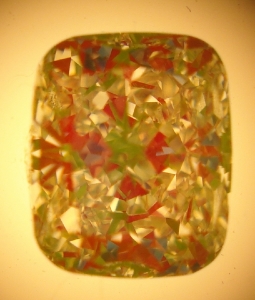
Garry H (Cut Nut) said:Rockdiamond said:Here is an example of a well cut crushed ice stone that is slightly lesser in cut.
There's a larger refelction in the table that you want if you're looking for consistent crushed ice.
In this case, we can see a clear correlation with the aset
Still- the area in the center does not allow you to see through the diamond- you won't see skin through it.
AS the stone moves that area is not very obvious.
Not the very best in crushed ice, but still quite nice to my eye in person.
RD your fingers are reflecting in the top of the stone - try a white glove?
And the dark center and some of the dark near the bottom of the stone that are red in ASET might be because of the lens or some other obstruction. As always, if you can tell us what the exact distances to lens, size of lens and color of camera body etc - then we can identify why the green in the center is dark in your pic.
If you are worried about giving away trade secrets, then email info to me - it will not be passed on - I have intimate knowledge of several vendors lighting and camera set ups and I do not pass the info on. Besides, I think with the LBox, it would be clear that I have no need to copy
Rockdiamond said:risingsun said:If I might add, the OP asked about a crushed ice cushion. Can we add one to the mix? I would like to see the difference in performance between the cushion and the radiant. Thanks.
Here's the aset for a cushion that exhibits a nice crushed ice look
Garry H (Cut Nut) said:Rockdiamond said:Here is an example of a well cut crushed ice stone that is slightly lesser in cut.
There's a larger refelction in the table that you want if you're looking for consistent crushed ice.
In this case, we can see a clear correlation with the aset
Still- the area in the center does not allow you to see through the diamond- you won't see skin through it.
AS the stone moves that area is not very obvious.
Not the very best in crushed ice, but still quite nice to my eye in person.
RD your fingers are reflecting in the top of the stone - try a white glove?
And the dark center and some of the dark near the bottom of the stone that are red in ASET might be because of the lens or some other obstruction. As always, if you can tell us what the exact distances to lens, size of lens and color of camera body etc - then we can identify why the green in the center is dark in your pic.
If you are worried about giving away trade secrets, then email info to me - it will not be passed on - I have intimate knowledge of several vendors lighting and camera set ups and I do not pass the info on. Besides, I think with the LBox, it would be clear that I have no need to copy
Garry- the front of the camera is grey( not shiny)
I watched your youtube describing how to use the IS( but you mentioned it works with the aset- and it does)
I placed the camera directly on the aset, as you instructed.
PS- I really would love your email address Garry- I don't have it.
I'm just going to throw this out there:risingsun said:Thanks for the post, RDCan someone compare the ASETs for the cushion and the radiant? What are we seeing and what should we be seeing on a well cut crushed ice cushion

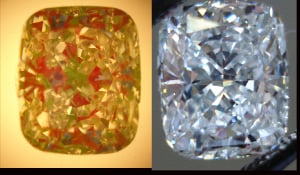
Rockdiamond said:I'm just going to throw this out there:risingsun said:Thanks for the post, RDCan someone compare the ASETs for the cushion and the radiant? What are we seeing and what should we be seeing on a well cut crushed ice cushion

The past few days using the aset and light, have strengthened my conviction that the information provided by this tool can just as easily mislead consumers as help them- possibly more likely to mislead than help. I don't belive this is intentional on anyone's part. It's a scientifically designed tool which provides objective informaiton. Context is the problem- it's just like asking people to read xrays- you need to be trained to do so- and having the patient at hand for physical examination is crucial to the analysis.
Regardless, I too am interested in the answer to Marian's question.
Here's an actual photo, next to the aset
eta- I can see a reasonable correlation between the aset, and areas of slight darkness in the real diamond. Still does not change my opinion on aset
risingsun said:Rockdiamond said:risingsun said:If I might add, the OP asked about a crushed ice cushion. Can we add one to the mix? I would like to see the difference in performance between the cushion and the radiant. Thanks.
Thanks for the post, RDCan someone compare the ASETs for the cushion and the radiant? What are we seeing and what should we be seeing on a well cut crushed ice cushion

Rockdiamond said:I will fix that and repost Garry
I'm still waiting for the answer to the following question:
For the purposes of this conversation, what difference does it make where the light is coming from, and how the stone is using it?
That is to say: A stone that shows a lot of green on the aset is utilizing light from lower angles. OK, so what?
Seriously, I ask with all due respect. Why should consumers worry about a diamond that is utilizing light from lower angles.
Garry H (Cut Nut) said:Rockdiamond said:I will fix that and repost Garry
I'm still waiting for the answer to the following question:
For the purposes of this conversation, what difference does it make where the light is coming from, and how the stone is using it?
That is to say: A stone that shows a lot of green on the aset is utilizing light from lower angles. OK, so what?
Seriously, I ask with all due respect. Why should consumers worry about a diamond that is utilizing light from lower angles.
You cannot be serious RD?
Think about the direction the light comes from and your post here
https://www.pricescope.com/communit...s-stud-earrings.149158/#post-2701698#p2701698
Read my advice to Deb. and turn your brain on

And turn one of the images upside down and have a good look.
You can search for Gilbertsonscope and make one out of colored card board and you will see even more becuase there are more colors.
If you have already accepted that you are looking for small virtual facets and a disordered and assymetric brightness signature than you will be accepting more leakage(white) and more regions that receive light from only lower angles(green).
Rockdiamond said:For example, well cut rounds don't handle direct sunlight very well.
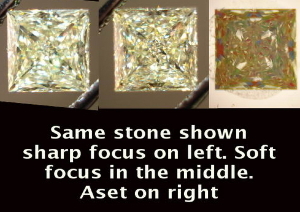
Garry the way it seems to me
I'll get a scan for you, if you wish
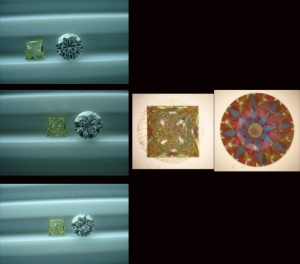
Rockdiamond said:There is no method without drawbacks.
I actually love using the aset- and have started to include aset images in our videos- some listings may also follow suit.
The princess cut I used- and others similar to it- are very bright perceptibly. Though I'm sure we can prove rounds ( for example) are brighter- or return more light.
How's this for a series of shots taken with the diamonds held close under the diamond grading lamp, the camera in the position a head would be in looking at them.
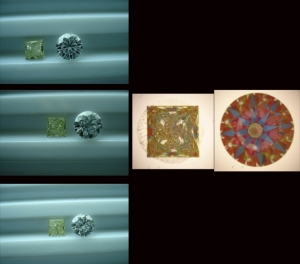
Garry H (Cut Nut) said:Rockdiamond said:I'm just going to throw this out there:risingsun said:Thanks for the post, RDCan someone compare the ASETs for the cushion and the radiant? What are we seeing and what should we be seeing on a well cut crushed ice cushion

The past few days using the aset and light, have strengthened my conviction that the information provided by this tool can just as easily mislead consumers as help them- possibly more likely to mislead than help. I don't belive this is intentional on anyone's part. It's a scientifically designed tool which provides objective informaiton. Context is the problem- it's just like asking people to read xrays- you need to be trained to do so- and having the patient at hand for physical examination is crucial to the analysis.
Regardless, I too am interested in the answer to Marian's question.
Here's an actual photo, next to the aset
eta- I can see a reasonable correlation between the aset, and areas of slight darkness in the real diamond. Still does not change my opinion on aset
For starters you can see the photo's need to be switched vertically. Get it RD - have a close look

ChunkyCushionLover said:risingsun said:Rockdiamond said:risingsun said:If I might add, the OP asked about a crushed ice cushion. Can we add one to the mix? I would like to see the difference in performance between the cushion and the radiant. Thanks.
Thanks for the post, RDCan someone compare the ASETs for the cushion and the radiant? What are we seeing and what should we be seeing on a well cut crushed ice cushion

RisingSun,
First I am talking objectively about potential brightness and am ignoring any beauty evaluations they are irrelevant to your question on the interpretation of white background ASET.
If you have already accepted that you are looking for small virtual facets and a disordered and assymetric brightness signature than you will be accepting more leakage(white) and more regions that receive light from only lower angles(green).
Even within these more broad standards you would still be looking for more green and red and less white. You want a greater surface area of the crown to at least be returning light to the viewer from lower angles.
More widespread areas of red is preferred to green and you want to avoid blue areas sorrounded by white areas as they will most commonly be areas of darkness or lack of life.
It should be pointed out an ASET image alone cannot tell you the general virtual facet pattern, regions that are the same color in the ASET are receiving light from the same angular range but those ranges are broad and one solid color may contain many smaller virtual facets breaking up the pattern in the ASET.
kenny said:Cehrabehra said:Deb, the reason that you don't have the info you seek is because everyone is still arguing about what it is. You dared to dip your toe into the cushion frontier and it's buyer beware over here. Sure you could get the advice of a dozen people, but they won't all agree anyway. And don't interrupt them, this is the debate I have been pushing for for 4 years now and they're just getting warmed up! I'm sure CCL can c&p his spiel.
Yeah, I'm glad I'm not pursuing a cushion.
It would be like entering a boxing ring.
Better to be in love with asschers where nobody really says much of anything.
Thank you for your explanation, ccl. This makes sense to me. I am used to reading ASETs for RB H&A diamonds and needed some information about the type of stones under discussion. As Garry mentioned, in his post above, the ASET could be very helpful in assessing a fancy stone, but the evaluator must understand what they are seeing in the ASET. Would anyone like to write a journal article on this topic?...or we could sticky this thread!
